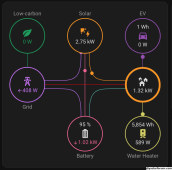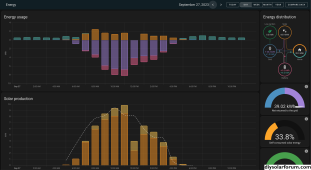Which is exactly what I'll be doing.
I expect the vast majority of my car's energy to come from my own rooftop solar PV. That my EVSE will be able to follow the available excess solar all the way down to a 6 A charge rate is still useful to me. It might not be much but that's energy I'd rather have in the car than not. Naturally when the PV is cranking it out the the EVSE can ramp up charging accordingly. My car's AC charger is limited to 6.6 kW (~39 km/hour charging).
I do not want to import energy from the grid if I can avoid doing so. Grid energy costs me between 33-61 c/kWh depending on time of day while I get 12 c/kW credit for feeding any excess energy back. So when the clouds come over, or we put on the ducted aircon, the water heater PV diverter is heating water, then I want the EV to adjust its charging accordingly.
At ~12,000 km/year, that's about 2 MWh of charge energy needed. ~A$240/year to power the car from foregone export credit. If I used overnight off-peak it would be closer to A$660.
I'm not totally following you.
I ordered an openEVSE unit a few weeks ago that supposedly allows a dynamic charge rate via an API which I want to leverage. No other unit I've researched or used allows it. The adjustable units I have/had required you to set the rate before plugging into the vehicle, after which you are locked at that rate. What EVSE did you find that allows this? (the spec does BTW) Further, what control software are you running that is monitoring your PV and adjusting your EV output accordingly? (I'm planning on writing something).
6600 is an odd rate, what kind of car is it? All of the non-Tesla EV's I've looked at have onboard level 2 chargers up to 240/32 (7600W) or better. I think the Lucid actually has a full 50A (12000W) AC unit, and a number of the newer vehicles ship with a 40A (9600W) unit.
Based on your 5.9km/KWH your only talking 10 klicks/hour at 1500, all of which assumes you are at home during the day/sunlight hours, 7 days a week to plug in to get your 350 klicks of range. In other words you can only drive at night. So IMNSHO a 6A charge rate is fairly useless. I've charged a time or two at 120/12A, it's pathetic. Unless you are not driving at all, it's not worth the bother. If you are pumping off-peak grid, you might as well just max out the rate. If you are trying to shave a few amps off your PV to charge a car battery you are likely to end up a tad frustrated. The last time I leveraged a 120/12 was when I went to a cabin that had an outlet, and the car was pretty much parked for two days. It didn't fill it up, but I was able to get enough to get back home before without charging at an EA. I saved $8 (EA is pricey).
The problem is EV's use a LOT of electricity, and electricity is just not that expensive even on-peak. My EV's have 64KWH battery packs, I only have 32KWH of battery for my solar, I want to double that. I try and optimize my charging times during daytime to soak up excess PV output, but if I could only pull 1500W, I think I'd just plug in at night. I might also note that it takes more than 32KWH to put 32KWH in my car. I do want to do something similar to what you envision, I have relays and switches all over the place including on my EV charging pedestal, so at some point I hope to be able to accomplish what you are discussing in an automated fashion, I've just not seen anything that will do it without me getting happy writing code.






